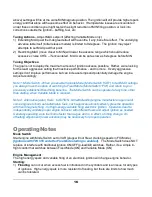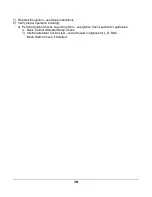
10
Long Reach (LR) vs. Short Reach (SR) Cylinders
Cylinders are made with two different spark plug thread depths. Match
spark plugs and plug adapters (LR or SR) to the cylinder depth when
ordering.
1) LR or SR cylinders can be identified by the aircraft spark plug call-out
for your engine. If it has the letter “M” - as in RE
M
XXX, you will need SR
plugs and adapters. If it has the le
tter “B” as in RE
B
XXX, you will need LR plugs and adapters.
The plug call-out can be:
a) Read directly from the side of your old aircraft style plugs.
b) Found on an aviation spark plug replacement chart.
2) Cylinder thread depth can also be measured directly, which identifies the correct adapter:
a)
Short Reach (“SR”) adapters have external thread length of approx. 1/2”.
b)
Long Reach (“LR”) adapters have external thread length of approx. 3/4”
Spark Plugs -
See Appendix 1 for specific spark plug recommendations.
IMPORTANT
:
Remember to
FIRST
install each spark plug in the adapter (fully seated and finger
tight).
THEN,
insert the combined plug/adapter assembly in the engine and tighten to
18 ft/lb.
(standard auto plug torque) through the spark plug ONLY.
Do NOT torque the adapter itself.
If
you torque the adapters directly, stress will be focused underneath the adapter head and it can fail
during installation. Such failures are not covered under warranty. Use anti-seize (sparingly) on the
outer/engine side of adapters. Auto plug manufacturers do not recommend anti-seize on their
plugs.
Manifold Pressure (MAP)
The ignition comes with 3’ of 1/8”x1/4” silicone tubing and a 1/8”
barbed nipple to 1/8” NPT brass fitting (packed separately) for use in
connecting manifold pressure. You could also use the female 1/8” NPT
in the ignition to attach your own larger MAP hardware if preferred.
The ignition has both electronic and mechanical MAP pulse
dampening built in.
With
normally aspirated
engines, the MAP tube
is a fail-safe input. Meaning if the MAP plumbing fails, plug firing in
Variable Mode will automatically retard to a flyable, but slightly less
efficient, firing position. If installing two ignitions, run a single MAP
tube to the accessory area, and then tee the MAP line to reach each ignition. If you already have a
manifold pressure gauge, tee into that existing line for your pressure source.
With
turbo normalized or boosted
engines, MAP plumbing is
NOT
considered fail-safe. A MAP
plumbing failure can, in certain conditions, call for more ignition advance than is appropriate or safe.
Excess advance can result in loss of power, overheating, and/or damage to the engine. For this
reason:
1) The MAP plumbing for two ignitions should be separate, so a plumbing failure on one side
would affect only one
– not both ignitions.
SR LR LRX
LRX
MAP-
1/8” Barb
(shown) or 1/8
NPT if brass fitting
is removed.


























